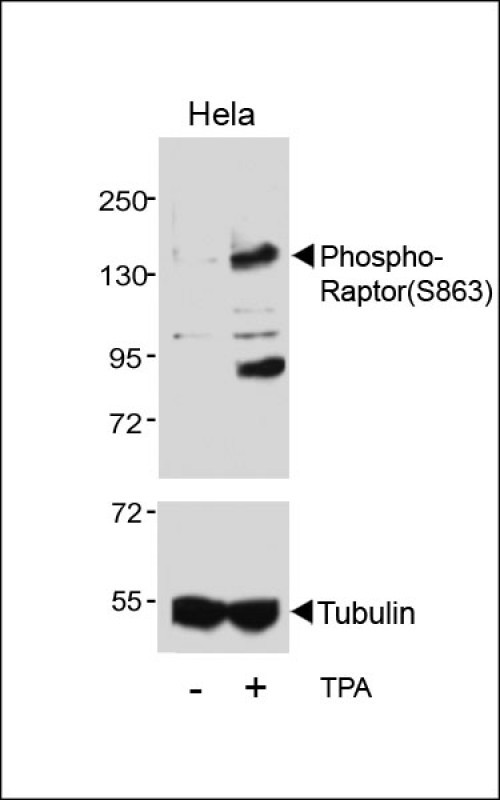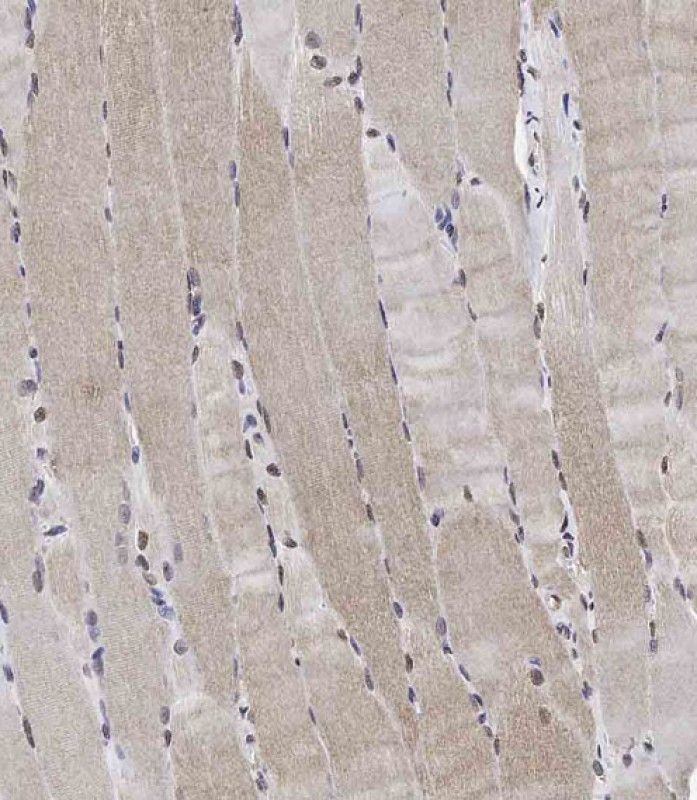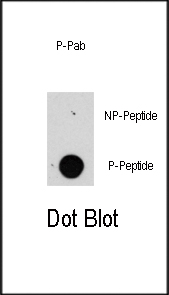Application 
| IHC-P, DB, WB, E |
|---|---|
| Primary Accession | Q8N122 |
| Reactivity | Human |
| Host | Rabbit |
| Clonality | Polyclonal |
| Isotype | Rabbit IgG |
| Calculated MW | 149038 Da |
| Gene ID | 57521 |
|---|---|
| Other Names | Regulatory-associated protein of mTOR, Raptor, p150 target of rapamycin (TOR)-scaffold protein, RPTOR, KIAA1303, RAPTOR |
| Target/Specificity | This Raptor Antibody is generated from rabbits immunized with a KLH conjugated synthetic phosphopeptide corresponding to amino acid residues surrounding S863 of human Raptor. |
| Dilution | WB~~1:500 IHC-P~~1:100 DB~~1:500 |
| Format | Purified polyclonal antibody supplied in PBS with 0.09% (W/V) sodium azide. This antibody is purified through a protein A column, followed by peptide affinity purification. |
| Storage | Maintain refrigerated at 2-8°C for up to 2 weeks. For long term storage store at -20°C in small aliquots to prevent freeze-thaw cycles. |
| Precautions | Phospho-Raptor(S863) Antibody is for research use only and not for use in diagnostic or therapeutic procedures. |
| Name | RPTOR (HGNC:30287) |
|---|---|
| Function | Component of the mechanistic target of rapamycin complex 1 (mTORC1), an evolutionarily conserved central nutrient sensor that stimulates anabolic reactions and macromolecule biosynthesis to promote cellular biomass generation and growth (PubMed:12150925, PubMed:12150926, PubMed:12747827, PubMed:24403073, PubMed:26588989, PubMed:32561715, PubMed:37541260). In response to nutrients, growth factors or amino acids, mTORC1 is recruited to the lysosome membrane and promotes protein, lipid and nucleotide synthesis by phosphorylating several substrates, such as ribosomal protein S6 kinase (RPS6KB1 and RPS6KB2) and EIF4EBP1 (4E-BP1) (PubMed:12150925, PubMed:12150926, PubMed:12747827, PubMed:24403073, PubMed:26588989, PubMed:37541260). In the same time, it inhibits catabolic pathways by phosphorylating the autophagy initiation components ULK1 and ATG13, as well as transcription factor TFEB, a master regulators of lysosomal biogenesis and autophagy (PubMed:12150925, PubMed:12150926, PubMed:12747827, PubMed:24403073, PubMed:32561715, PubMed:37541260). The mTORC1 complex is inhibited in response to starvation and amino acid depletion (PubMed:12150925, PubMed:12150926, PubMed:12747827, PubMed:24403073, PubMed:37541260). Within the mTORC1 complex, RPTOR acts both as a molecular adapter, which (1) mediates recruitment of mTORC1 to lysosomal membranes via interaction with small GTPases Rag (RagA/RRAGA, RagB/RRAGB, RagC/RRAGC and/or RagD/RRAGD), and a (2) substrate-specific adapter, which promotes substrate specificity by binding to TOS motif- containing proteins and direct them towards the active site of the MTOR kinase domain for phosphorylation (PubMed:12747827, PubMed:24403073, PubMed:26588989, PubMed:37541260). mTORC1 complex regulates many cellular processes, such as odontoblast and osteoclast differentiation or neuronal transmission (By similarity). mTORC1 complex in excitatory neuronal transmission is required for the prosocial behavior induced by the psychoactive substance lysergic acid diethylamide (LSD) (By similarity). |
| Cellular Location | Lysosome membrane. Cytoplasm Cytoplasmic granule. Note=Targeting to lysosomes depends on amino acid availability: recruited to lysosome membranes via interaction with GTP-bound form of RagA/RRAGA (or RagB/RRAGB) in complex with the GDP-bound form of RagC/RRAGC (or RagD/RRAGD), promoting recruitment of mTORC1 to the lysosomes (PubMed:31601708, PubMed:31601764). In arsenite-stressed cells, accumulates in stress granules when associated with SPAG5 and association with lysosomes is drastically decreased (PubMed:23953116). |
| Tissue Location | Highly expressed in skeletal muscle, and in a lesser extent in brain, lung, small intestine, kidney and placenta |







